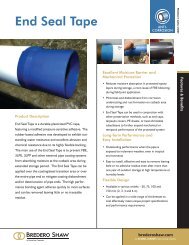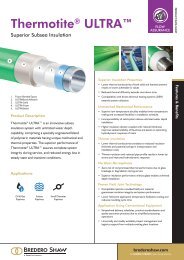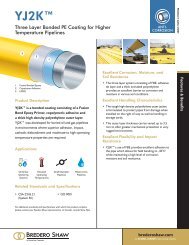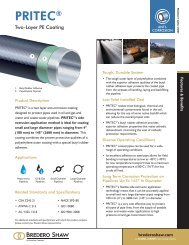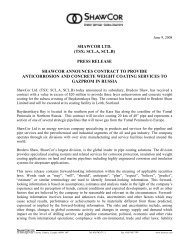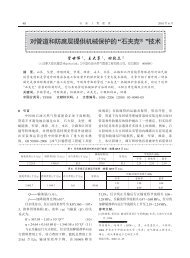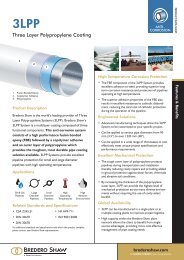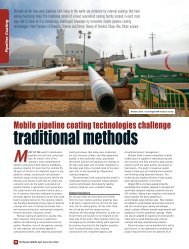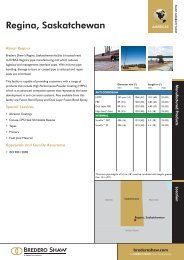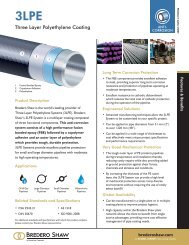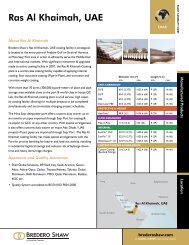Long-Term Performance - Bredero Shaw
Long-Term Performance - Bredero Shaw
Long-Term Performance - Bredero Shaw
- No tags were found...
You also want an ePaper? Increase the reach of your titles
YUMPU automatically turns print PDFs into web optimized ePapers that Google loves.
( protecting against corrosion )quality control, which should not have been reliedon for qualifying the tested coating material for itslong-term performance. The proper approach shouldbe generating the cathodic disbondment rate ratherthan a single test for a specified period of time. Figure1 shows two coatings where the 28 days result maybe better in series 2, however the coating in series 1would be a better choice.Figure 2 shows the T gof two FBE materials afterexposure to wet service environment at 65 ˚C forFigure 5. Weld ‘tenting’ of a conventional 3LPE coating.Figure 6a duration of up to 120 days. Both standard FBEmaterials show a considerable drop in T g(20 - 25 °C) after immersion in water due to FBEplasticisation caused by moisture absorption. TheseT gvalues are measured per CSA Z245.20-2006 at aheating rate of 20 °C/min. The T gat slower heatingrates close to the pipeline operating conditions(close to 0 °C) would be approximately 10 °C lower.Learning from the results given in Figure 2, oneshould be careful in using T gas a limiting factor,particularly when only dry T gvalues are considered inmany standards and specifications for pipe coatings.Different materials behave differently at temperaturesabove T g. Some have drastic increases in permeationrates while others retain their properties much better.It is of main interest for design engineers to determinethe long-term performance of the FBE material usedin wet environments, and to define the maximumoperating temperature limit of the coated pipelineproperly.Figure 6. New approach to a multi-layer PO coating for anexcellent great weld coverage. 8Critical parametersFBE primerTable 1 shows the correlation of adhesion rating withfilm thickness of an FBE coating after hot water soaktesting as per CSA Z245.20 (CSA’s criterion is a ratingTable 2. Impact of surface preparation on adhesion property of two FBE coatingsMaterial Surface preparation Adhesion rating (hot water soak, 75 ˚C)Grit type Profile, Rz (µm) Peak count/in. 2 days 7 days 14 days 28 days 60 days 120 daysFBE#1 GL25 62 74 1 1 1 1 2.3 2.3FBE#1 GL80 35 92 1 1 1 1 1.2 4FBE#1 Substrate prepared by power grinding 1 1 1 1 5 5FBE#2 GL25 60 72 1 5 5 5 5 5FBE#2 GL80 40 98 1 1 5 5 5 5FBE#2 Substrate prepared by power grinding 1 3 3 5 5 5Table 3. Impact of surface preparation on cathodic disbondment property of FBE#1 coatingMaterial Surface preparation Cathodic disbondment (-1.5 V, 65 ˚C)Grit typeProfile, Rz(µm)Peak count/in.14 days 28 daysFBE#1 GL25 62 74 5 mm 16 mmFBE#1 GL80 40 77 5 mm 23 mmFBE#1 Substrate prepared by power grinding 25 mm Total disbondmentTable 4. Impact of improved surface cleanliness by phosphoric acid treatment on properties of FBE#1 coatingSurface preparation (GL25 grit) Avg. CD Adhesion rating (hot water soak, 75 ˚C)Acid treatment Profile Rz (µm) Peak count/in. 28 days, -1.5V,65 ˚C2 days 28 days 60 days 90 days 120 days 150 daysYes 59 - 66 74 - 76 16 mm 1 1 1.2 2 2 3No 54 - 62 73 - 75 16.5 mm 1 1 2.3 3 2.3 4www.worldpipelines.com Reprinted from World Pipelines November2008



